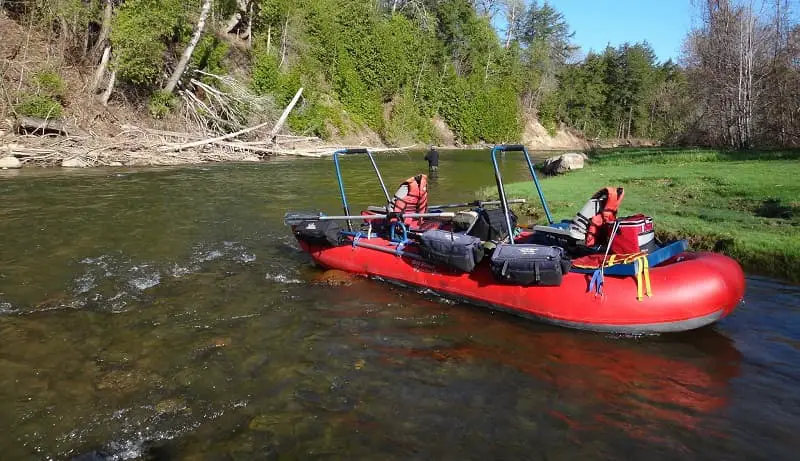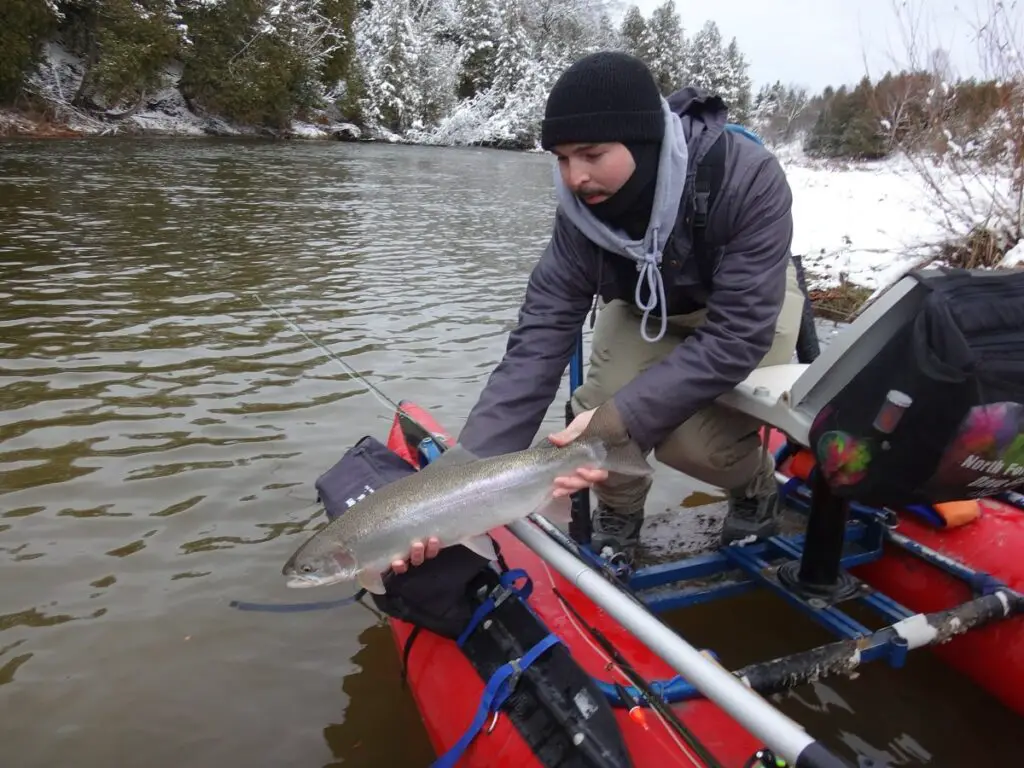Guide Tips For Fishing Rivers With River Boats

Guiding and fishing rivers with river boats has enabled my clients and friends to catch ten times more trout, steelhead, and salmon. These are my tips for doing river boat trips easier with one or more anglers and the advantages of using these types of boats.
Advantages Of Using A Boat
Let’s talk a little about why you should get a boat and why you will likely be able to catch more trout and other fish with one.

- No Walking: The first advantage is simply that there is less or no walking involved when you’re in a boat. This is great for less mobile angers or when fishing rivers with heavily wooded banks.
- Tough Banks: Some rivers have high banks, steep slopes, or heavily wooded banks that can’t be walked very easily. Boats are great on these rivers, especially for anglers who are not so sturdy on their feet.
- Older Anglers: Older anglers will find that the boat makes it easy for them to see tons of water with very little effort.
- Private Lands: fish through miles of private property that I can not access in any way other than drifting through. These sections tend to have more and bigger fish.
- More Fish: Boats get me far away from access spots and pressured water, so I tend to catch a lot more fish.
- Water Depths: Riverboats made for fly fishing or other river fishing methods can get through sections of the river that are as shallow as 4 inches deep.
- Ponds and Lakes: You can get to ponds and lakes that do not have boat launches where other boats can’t get to.
- Access: I tell my clients I can get my boat to any water that I can walk to, so I can fish just about anywhere.
Getting away from the crowds is actually one of the tips on my page, How To Catch Trout In A Stream: 19 Best Guide Tips, which is a good read for anyone looking to catch more trout.
Access Private Waters

Another major advantage of fly fishing boats is that you can get into sections of the river or around a pond or a lake where the land is all private property.
These private sections of the river or shoreline often have untouched big fish that nobody ever fishes for. With a boat, they are all yours.
Having a good boat is like having your own private water, and that makes for some great fishing.
You need to make sure you know the laws in your area. You might be able to drift through private property and either stay in the boat and only fish from the boat, or you might be able to get out and keep your feet in the river while you fish and then get back in and go.
In some parts of North America, even the river bottom is private, but in many cases, you can still get through the river as long as you do not get out of the boat, and that is where stand-up boats are the best option.
One thing you need to worry about on a smaller river is log jams, where you may need to get out and onto the private property just to get your boat through. Inflatable lightweight boats are best for this.

I have taken my big 15-foot inflatable river boats through rivers that were about 15 feet wide. I could even squeeze through sections of the river that were only 6 feet wide.
As long as I had enough room for my oars on both sides, I could run the river.
I could also get through shallow spots that were only four inches deep, and if I needed to on some boats like my pontoon boat, I could stand up and walk the boat through or around tight spots and shallow water.
Tips When Using Fly Fishing Boats

The main disadvantage of going down the river in fly fishing boats is that it requires a little more work and planning.
Once you go down the river, you will need to get back to your vehicle somehow, and this can be the biggest problem with fly fishing river boats, but it’s not as much work as it sounds, and the benefits of fly fishing boats outweigh the negatives.
Buddy System

Many guys that I know do their boat trips with a buddy or two. They take two vehicles, and one vehicle stays up where you put your boat in, and the other stays down where you pull your boats out.
You can do this with one lightweight double-man boat like the McKenzie Drifter or with a couple of single-man boats like the Colorado XT Pontoon Boat.
The way I do it is I meet my buddy where we take the boats out, then we throw all his gear and his boat (if we are running two boats) in my vehicle, and then we head up to where we launch. We drop both boats or the one two-man boat in the river, and then we head down the river for a great day of fishing.
At the end of the day, we pack everything into his vehicle and head back to my vehicle.
Single Man Method

Single-man pontoon boats are great for getting anglers into untouched water with great scenery and big fish. Single-man boats can weigh less than 25 pounds and can go anywhere you can walk.
Single-man pontoon boats are the most popular boats and are well worth looking into.
I have done single-man pontoon boot trips using three different methods, and this is how I do it easily.
Walk Back Method
On public lands where I can walk, I will use my light-weight-packable pontoon boat like the 2022 Raptor Lite Speed X, which weighs under 25 pounds for this method, or the Roanoke Pontoon Boat, which weighs about 43 pounds.
I will drift and fish my way down the river for a mile or two, and then at the end of the day, I will pack up my boat and gear in a backpack, and I will walk back up the river to the vehicle.
This walk-back method is only for guys who can walk two miles with 20 to 45 pounds of gear on their backs.
The advantage of the walk-back method is that a guy who walks a mile down the river then has to walk back, and he will end up walking two miles but only fishing one mile of water.
With the walk-back method, you can effortlessly fish two miles of river by boat, then walk back to the car, and you still walk the same two miles that the other guy did, but you get to fish twice as much water and catch more fish.
Shuttle Back Method
The other method that I do more than the first method is the shuttle back method with small boats. I launch my boat and fish and drift down the river. Sometimes, I will cover 3 to 6 miles of river in a day with this method.
Once I get down to the end of the river where I pull my boat out, I simply deflate the boat and then pack everything up into a duffel bag or two, (a hockey bag works great), and then I call an Uber or a cab or maybe get someone I know to pick me up to take me back to my vehicle.
I have to say that Uber has made using fly fishing boats far easier to do than ever before.
The fact that some fly fishing boats weigh less than 25 pounds and can easily be packed up has also made it extremely easy to do.
Just make sure ahead of time that you can get an Uber or a cab if you are in a remote area where cell reception might be spotty, and that your phone battery lasts all day so you can call your ride.
You might even be able to pre-schedule a pick-up for a certain time so you know they will be there when you arrive, just don’t be late.
I have used Uber, taxis, and shuttle services to get me back to my vehicle, and with the right fly fishing boat, this is super easy to do.

Lock The Boat Method

With bigger pontoon boats that can’t be packed and thrown into the trunk of an Uber or a cab, I will park my vehicle at the launch spot and then drift down the river, and when I get to the end, I will hide my boat in the bush or just lock it to a tree or post with a heavy chain.
I will then call an Uber or a cab to take me and all my gear except for my boat back to my vehicle. I will then return back to get my boat.
This is not ideal in remote areas, but since most guys don’t carry heavy bolt cutters, I have never had a problem, and often I’m only gone for five to ten minutes. Use this method at your own risk.
Whatever method you use, boats are a lot of fun, provide opportunities to catch more fish and see a lot more river than you would on foot. Don’t forget to check out my article on the Best Fly Fishing Boats and the pros and cons of each.
Tight Lines
Graham
